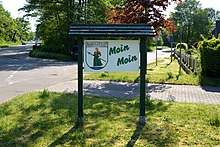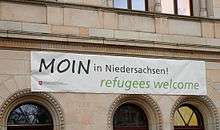Moin
Moin, moi or mojn is a Low German, Frisian, High German (moin [moin] or Moin, [Moin])[1], Danish (mojn)[2] and Kashubian (mòjn) greeting from East Frisia, Southern Schleswig (including North Frisia and Flensburg), Bremen, Holstein, Mecklenburg-Vorpommern, the eastern and northern Netherlands, Southern Jutland in Denmark and parts of Kashubia.

It means "hello" and, in some places, "goodbye" as well.
Usage

Moin is used at all times of day, not just in the morning (see Etymology section below).[3] The reduplicated form moin moin is often heard,[4] although some authors claim it is regarded by locals as tourists' usage.[5]
The German comic character Werner always greets with Moin.
Etymology
| Look up moin in Wiktionary, the free dictionary. |
Many people think that moin derives from various regional pronunciations of (Guten) Morgen ("good morning"), which tend to alter, vocalise, or skip rg. However, the word may actually also derive from the Dutch, Frisian, and Low German word mo(o)i, meaning "beautiful" or "good".[3][5] Similar forms in Low Saxon are mooien Dag, mooien Abend, mooien Mor(g)en. Possibly, as is common in etymology, one origin is correct (either from Morgen or mooi) but spread thanks to its oral assimilation with the other term.
The Luxembourgish cognate of the word is moien, which can mean either "hi" or "morning" (gudde Moien! means "good morning!").
Unlike Guten Morgen, moin can be used 24 hours a day. It is semantically equivalent to the Low Saxon (Plattdüütsch) greeting Dagg and replaced it in many areas. In Hessen, mojn is used for hello and good bye, but mojn mojn is solely used for good bye. The double form Moin Moin is also used as an all day greeting in for example Flensburg that belonged to Denmark until 1864 and the Swedish region of Scania, part of Denmark until 1658.
Moin is also very similar to the Norwegian greeting "Morn" which is also often used twice when the greeter is in a particularly good mood. It is short for "god morgen" which means "good morning", but people use it at all times of the day.
Moi
In Finland, a similar greeting moi (pronounced [ˈmoi]) is used for "hello", "hi" in the Finnish language. However, "moi moi" is used as a good bye, similarly to "bye bye" in English, even with a similar intonation. Both are particularly typical of Southwestern Finnish, but through internal migration spread to the capital and with the help of TV to the rest of the language area. Moi's use is identical to that of hei: diminutive forms heippa and moikka, and duplication as a good bye. Southwest Finland traded with Hanseatic cities, so it is plausible that the greeting was borrowed from their dialects.
Moro is found in some parts of Finland and has also been used in the same way as moi. It is theorised that it comes from Tampere due to its large number of foreign workers and like moi has been borrowed from morrow and abbreviated.
"Moi" is also used in Dutch Low Saxon dialects in the eastern part of the provinces Groningen and Drenthe.
References
| Wikimedia Commons has media related to Moin. |
- Duden: moin [moin], Moin, [Moin]
- Den Danske Ordbog: mojn
- ut Westerend, Volker (2004). Nordseefische gehen auf Wurm: Schöne Ferien an der Waterkant. Der lustigste Urlaubsratgeber am plattdeutschen Strand (in German). BoD – Books on Demand. pp. 11–12. ISBN 3-8334-0025-0. Retrieved 2011-05-31.
- Plattmaster.de, Moinmoin - wat heet dat?. Retrieved 2011-05-31.
- Bormann, Andreas (2005). Nordseeküste Schleswig-Holstein (in German) (2nd ed.). Mair Dumont Marco Polo. p. 15. ISBN 3-8297-0302-3. Retrieved 2011-05-31.